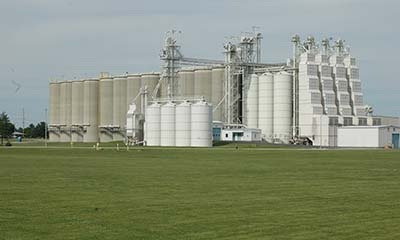
U.S. grain merchandisers are beginning the new-crop growing season facing significant challenges, according to a recent research report by CoBank. Low price volatility, ample grain and oilseed inventories, slow farmer selling and an anemic export program suggest elevators are in for a difficult 2016-2017 season.

“With no relief immediately in sight, grain merchandisers will undergo further belt-tightening in the year ahead,” says Tanner Ehmke, senior economist with CoBank’s Knowledge Exchange Division.
With no relief immediately in sight, grain merchandisers will undergo further belt-tightening in the year ahead,” says Tanner Ehmke, senior economist with CoBank’s Knowledge Exchange Division. “Most grain elevators have solid balance sheets thanks to multiple years of strong revenues. Nonetheless, pressure for consolidation will likely intensify in an environment of slimmer profit margins.”
Amid ample inventories in the U.S. and a lackluster export market, the grain and oilseed basis markets continue to remain stagnant, offering limited opportunities for elevators to profit on old-crop basis appreciation. However, grain elevators could still stand to profit by year’s end off the opportunity to buy wider new-crop basis postharvest, says Ehmke.
A growing concern among co-op managers is the availability of storage space this fall. High carryover stocks mean inventories will continue to build. Most years, inventories are about 10% farmer-owned, but many co-ops report that level at around 30% this year. Experts predict that only a major weather-induced crop failure could reverse this trend, and even then supplies are expected to remain sufficient to meet demand.
The calendar year has started with a stagnant basis market and on the heels of a weak grain drying harvest. (Chart) “You’ve got to have volatility in the markets to make money, but basis has been stagnant for elevators,” he says.
While the basis market has held steady across the U.S., grain merchandisers in the Western Corn Belt and the Plains have seen basis holding consistently weak since last fall while they hold the largest crop inventories seen in decades. Grain handlers in the Eastern Corn Belt, meanwhile, have experienced consistently narrower basis following last year’s drop in crop yields. Across the U.S., the ample supply scenario is sure to keep a lid on basis movement.
“Barring any significant weather-related crop losses this year, grain handlers could be tasked with managing huge farmer-owned inventories into the new-crop year and creating, at least temporarily, additional storage,” notes Ehmke. “Whether or not farmers will be willing to sell grain remains the co-ops’ wildcard.”
With the export market not there to draw stocks out and farmers are reluctant to let go of it, Ehmke says it is a cat and mouse game whether the elevator is caught in the middle carrying huge amounts of farmer-owned grain into the crop year.
The risk of a repeat La Niña event, which is normally associated with dryness in the Midwest, is another area of concern. The National Weather Service forecasts a 50% chance of another La Niña this fall.
Coop managers commonly report that last year’s harvest was the driest in recent memory, with revenues gleaned from grain drying services typically falling to one-third of normal. Typically it accounts for 8-10% of an elevator’s profits and much of that disappeared in 2015, he says. “We could see a repeat of that again this year,” Ehmke added.
With a stagnant basis market, and storage and weather concerns looming, co-op managers anticipate consolidation in the industry to continue. “Mergers, acquisitions or joint ventures could become more likely,” says Ehmke. “Efforts to reduce price risk exposure based on these headwinds will be critical for co-ops looking ahead to the end of 2016.”
If a current elevator manager is going to be retiring, grain cooperatives could be looking for someone to partner with or acquire in the compressed margin environment. “These types are going to be looking for dance partners when profits are down,” Ehmke says.
By this fall, however, coops hope to gain substantially from buying wider new-crop basis as farmers expand total corn and soybean acreage. Basis is likely to be cheap this fall, so for those who missed out in 2015, there may be new opportunities this year.
About the Author(s)
You May Also Like






